Journal of
eISSN: 2373-6445


Review Article Volume 9 Issue 6
Head of the Center of Professional Education for the Disabled, Vladimir State University named after Alexander and Nikolay Stoletovs, Russia
Correspondence: Shamanin NV, Head of the Center of Professional Education for the Disabled, Vladimir State University named after Alexander and Nikolay Stoletovs, 600000, Vladimir, Gorky str., 87, Russia
Received: November 28, 2017 | Published: November 20, 2018
Citation: Filatova OV, Shamanin NV. Personal particularities of people who have suffered acute cerebrovascular disorders. J Psychol Clin Psychiatry. 2018;9(6):631?633. DOI: 10.15406/jpcpy.2018.09.00600
Acute disorders of cerebral circulation - this term combines all types of acute disorders of cerebral circulation, which are accompanied by transient or persistent neurological symptoms. In recent years, unfortunately, there has been an increase in the number of patients with symptoms of disorders of cerebral circulation. It is sufficient to resort to a statistical reference in order to assess the scale of the problem. Annually in the world about 12 million calls to clinics with this kind of problems are registered. In Russia, this figure is more than 450,000 patients a year with a stroke diagnosis. The disease affects not only the physical condition of the patient, but also his psyche. Patients, who underwent acute cerebral circulation disorders (ACCD), have personality changes. After passage of a course of intensive therapy for this category of patients characteristic psychological features: emotional instability, uneasiness, anxiety, depressiveness. The disease leaves an imprint on their worldview, attitude to themselves. Our study of the psychological characteristics of the personality of patients who underwent an acute impairment of cerebral circulation was conducted based on the Vladimir Regional Clinical Hospital in Vladimir. Fifteen patients aged 45-65 years old who underwent acute disorders of cerebral circulation (ADCC) participated in the study. A control group of 15 people was formed, identical in age and sex. To determine the type of attitude to the disease, we conducted a methodic of the Institute named by Bekhterev "LOBI". The results are presented in the Figure 1.
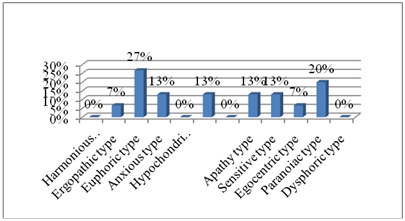
Figure 1 Results of diagnosis of the types of attitude towards the disease in the experimental group according to the questionnaire of the Institute named by Bekhterev (LOBI).
The euphoric type of attitude towards the disease is most pronounced in this group of patients. It is observed in 26.7% of the subjects. Patients with a euphoric type have hope that "the disease will pass by itself". They want to receive everything from life, despite the disease. Patients easily violate the regime of the day, although these disorders can adversely affect the course of the disease. In second place in terms of severity is a paranoid type (20% of the respondents in the experimental group). Patients are characterized by extreme suspicion of drugs, procedures and treatment. They tend to attribute all possible complications from treatment or side effects of drugs, negligence of personnel. In our study, 13.3% of patients with apathetic type of attitude to the disease were identified. They are distinguished by complete indifference to their own destiny, to the course of the disease and to the results of treatment. The results of diagnosis of the control group by this method showed the following results ( Figure 2).
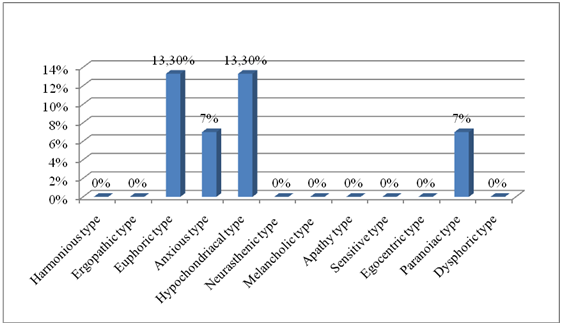
Figure 2 Results of diagnosis of the types of attitude towards the disease in the control group according to the questionnaire of the of the Institute named by Bekhterev (LOBI).
In the control group, 4 types of attitude to the disease were identified: hypochondriacal (13.3%), obsessive-sensitive (7%), euphoric (13.3%), paranoid (7%). Thus, it should be noted that, the system of relations associated with the disease may not fit into any of the described types. We are talking about mixed types, especially those close to the pattern of manifestations (anxiety-obsessive, euphoric-anosognosic, etc.). But the system of relations can’t yet form a single pattern. In such cases, the type of attitude towards the disease may not be diagnosed, and the traits of many or all types are more or less evenly distributed. At the second stage, a procedure was conducted on a questionnaire by 16 PF R. Cattell to identify the personality characteristics of patients in a situation of psychosomatic illness and an analysis of their differences with the personality characteristics of healthy people ( Figure 3).
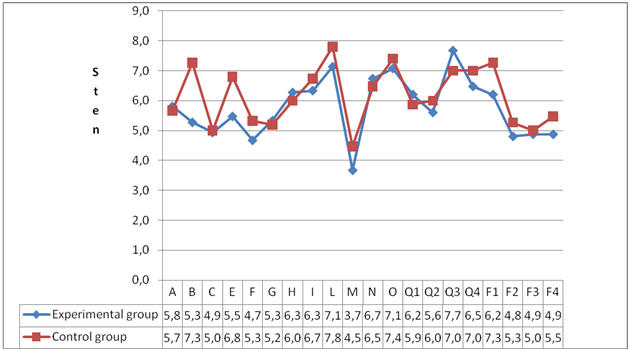
Figure 3 Results of a study of personality characteristics on a questionnaire of 16 PF R. Cattell in the control and experimental groups.
According to the results of the study using the questionnaire of R. Cattell in the experimental group, the following symptom complex of personality traits was revealed:
Conversation with medical personnel made it possible to reveal some emotional peculiarities of patients. The medical staff of the clinic notes increased emotionality. Patients easily begin to worry, are prone to anxiety, easily give up their positions. In the case of difficult situations, they begin to get irritated, quarrel, are exposed to frustration factors, easily upset. The results of the study of personality characteristics in the 16 PF R. Cattell questionnaires in the control group largely coincided with the results of the experimental group. Subjects are selective in communication and prefer to establish trusting relationships with people who are close to them in their interests, with whom they maintain an old relationship. They understand the problems of other people, but their own prefer to keep a secret and find a solution on their own. In everyday life they listen to the opinion of the group, respect it as much as their own. Despite this, responsible decisions prefer to be taken independently. Thus, the following personality traits are revealed in patients who undergo ONMC: emotional instability, anxiety, depressiveness, anxiety. The control group is characterized by a higher level of intellectual development, abstract thinking, balance, independence and responsibility. In order to study the degree of independence and activity of a person in achieving his goals, the method of "Level of subjective control" (USC) by J. Rotter was applied. The results are shown in Figure 4.
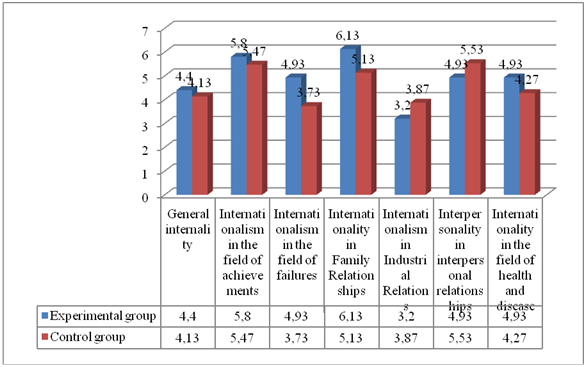
Figure 4 Results of the study of the features of the level of subjective control in patients who underwent acute disorders of cerebral circulation by J. Rotter.
From the presented histogram it follows that the patients who have suffered a stroke show a high level of internality in the field of achievements. All successes, achievements, realized goals are the result of their efforts. At the same time, there are low rates in the internality control. Patients with a stroke diagnosis are inclined to attribute responsibility for the troubles and suffering that arise in their lives to other people or circumstances. Manifestations of the disease affect the sphere of family relations: the patient considers him responsible for the events occurring in his family life. Subjects do not take the role of suffering, victims, who can not affect the environment. Low results were obtained on the scale of internality in relation to health and disease. This allows us to conclude that people who have suffered a stroke consider their disease to be the result of a case, not acknowledging their own responsibility and are hoping for recovery as a result of the actions of other people, especially doctors. In the range of "very low indicators" on the scale of internality in the field of production relations, results were obtained for the subjects of the experimental group. This parents tend to ascribe more important importance to external circumstances in their lives (leadership, comrades at work, the factor of "luck - bad luck"). In the control group allowed fixing the highest result on the scale of "internality in the field of interpersonal relations". They consider themselves capable of controlling their formal and informal relationships with other people. Thus, patients who have suffered a stroke have high rates in internality of achievements, family relationships and low in areas of failures, industrial relations, health and disease. In the control group, only internality in the field of interpersonal relationships is of a high level. The other indicators on the scales speak of the internal types of control. To determine the level of situational and personal anxiety in the subjects, a procedure was conducted using the "Spielberger-Hanin anxiety scale (STAI)" technique ( Figure 5).
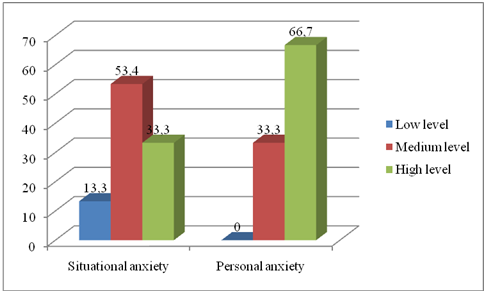
Figure 5 Results on the technique of diagnosis of self-esteem C.D. Spielberger, L. Khanin (assessment of situational and personal anxiety) in the experimental group.
Analysis of the results of the experimental group showed that the level of situational anxiety among the subjects was distributed as follows: low - 13.3%, moderate - 53.4%, high - 33.3%. The diagnosis of personal anxiety showed that none of the patients had a low level. The average level is 33.3% of patients, 66.7% have a high level of personal anxiety. A certain (average) level of anxiety is a natural and indispensable feature of an active, active individual. Each person has his or her optimal, or desirable, level of anxiety - this is the so-called useful anxiety. Most of the subjects of the experimental group (53.4%) have an average level of situational anxiety. Situational anxiety is more dependent on current problems and experiences. Proceeding from this, it can be concluded that patients are inclined to trust doctors, medical personnel, as well as prescribed treatment and do not worry about their own lives ( Figure 6). A similar survey in the control group showed that 53.3% and 60% of healthy subjects had high rates of personal and situational anxiety, respectively. This fact gives us reason to assume that people have anxiety states in a variety of situations. Thus, in patients who underwent acute disorders of cerebral circulation, a high index of personal anxiety is noted. Patients are distinguished by high demands, categorical and staging of global problems. In the control group, this indicator has a lower value. The problem of psychosomatic ratio is one of the most complex problems of modern medicine. Despite the importance and a large number of publications devoted to this topic, not all psychosomatic diseases have been fully studied. This category includes acute disorders of cerebral circulation. The study showed a number of psychological features in patients who had a stroke. There is a presence of euphoric, paranoid, apathetic, obsessive-phobic type of experiencing the disease. Patients are characterized by emotional instability, low level of internality and fitness in relation to health and illness, industrial and family relationships, the complexity of interpersonal contacts, on the basis of the study, we can talk about the need for psychological assistance during the rehabilitation period in post-stroke patients. The tasks, methods and prognosis of rehabilitation treatment of patients who underwent cerebral stroke can vary significantly depending on the nature and severity of the defect, the pathology of the patient's potential for spontaneous recovery, and the possibility of conducting active studies. The following factors are crucial for a differentiated approach to the appointment of rehabilitation measures:
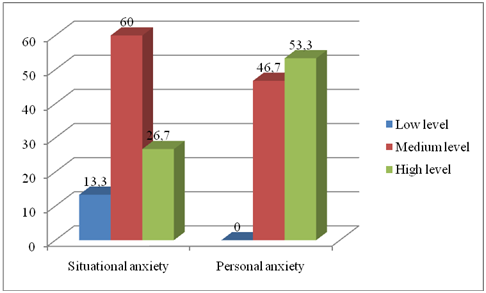
Figure 6 Results on the technique of diagnosis of self-esteem C.D. Spielberger, L. Khanin (assessment of situational and personal anxiety) in the control group.
The degree of severity of post-stroke disorders (motor, sensory, coordinative, etc.) is assessed as "pronounced", "moderate", "light" "no violations".
For patients of the first clinic-rehabilitation group, the goal of rehabilitation is the prevention of disability.
The objectives of rehabilitation treatment are
Among the methods of rehabilitation treatment are the following:
The average duration of a course in the conditions of a specialized rehabilitation department or center, which is necessary to perform the above tasks, is usually 20-40 days. At the end of the course of medical rehabilitation, there may be a need for employment of these patients, selection of a workplace with the exclusion of significant physical and psychoemotional loads. Acute disorders of cerebral circulation often have a strong psycho traumatic effect on the patient, violating his life plans and complicating relationships with surrounding people. In addition, chronic emotional stress exacerbates pathology. Various psychopathological syndromes (primarily depressive) arise, according to various authors, in 20-60% of patients who underwent cerebral stroke and significantly complicate the restoration of impaired functions. All this necessitates the need for psychocorrectional work with each patient in the rehabilitation process. The goal of psycho correction in this case is to reduce mental disadaptation caused by a disease or other problems, increase stress-resistance, and the formation of the most appropriate type of attitude towards a disease aimed at recovery.
None.
The authors declare that there is no conflict of interest.

©2018 Filatova, et al. This is an open access article distributed under the terms of the, which permits unrestricted use, distribution, and build upon your work non-commercially.